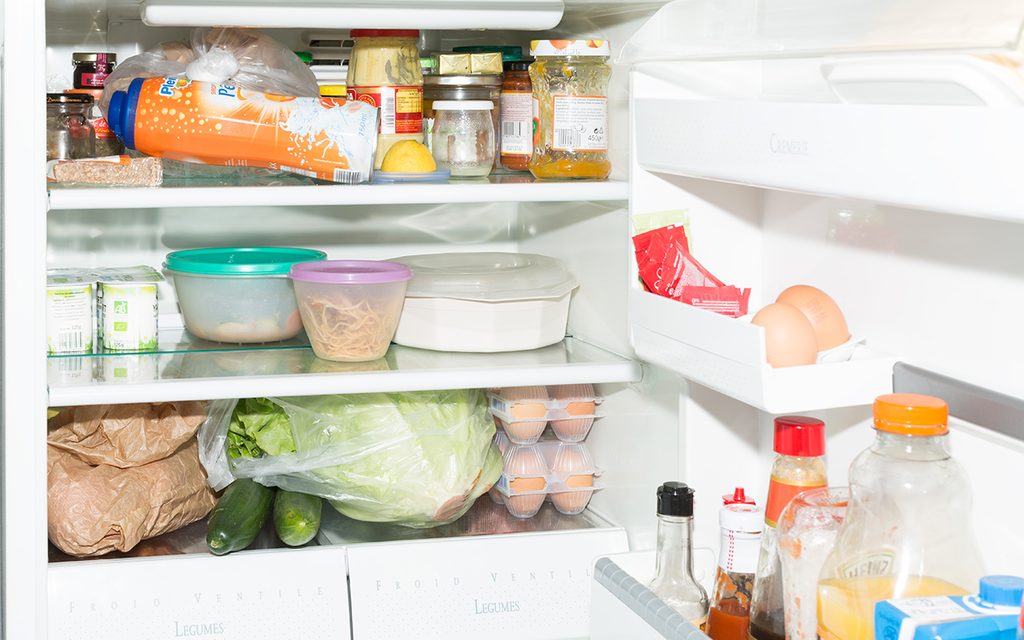This Is How Long Your Food Is Good for in the Refrigerator
Updated: Mar. 12, 2024

From meat to produce to condiments, here's how long staple foods will really last in the refrigerator.
Where would your family be without a spacious refrigerator? Well, you’d be making a lot more trips to the grocery store, for starters. Whether you’re stocking up on grocery staples or want to repurpose some leftovers, a great fridge is the gift that keeps on giving. But just because you placed all your produce, condiments and sweet treats in the refrigerator doesn’t mean they’ll last forever.
While most of your groceries will be stamped with an expiration date or a “Sell By” date, some foods are safe to eat after that date passes. Here’s a closer look at the expected shelf life of everyday foods.
How Long Is Food Good in the Fridge?

Eggs, Meat & Fish
- Bacon, Uncooked: 7 days ( check how long bacon lasts in the fridge or freezer to keep it fresh and ready to use)
- Beef Roast, Steaks or Ribs, Uncooked: 3 to 5 days
- Chicken, Cooked (including rotisserie): 3 to 4 days
- Chicken, Uncooked: 1 to 2 days
- Eggs, Hard Boiled: 1 week
- Eggs, Raw: 3 to 5 weeks (Find out how long eggs can last in the fridge)
- Egg Salad: 3 to 5 days
- Fish, Cooked: 3 to 4 days
- Fish, Uncooked: 1 to 2 days
- Ground Beef, Cooked: 3 to 4 days
- Ground Beef, Uncooked: 1 to 2 days
- Hot Dogs, Opened: 1 week
- Hot Dogs, Unopened: 2 weeks
- Lunch Meat, Opened: 3 to 5 days
- Lunch Meat, Unopened: 2 weeks
- Pork Roast, Chops or Ribs, Uncooked: 3 to 5 days
- Sausage, Uncooked: 1 to 2 days
- Shrimp, Cooked: 3 to 4 days
- Shrimp, Uncooked: 1 to 2 days
Produce & Plant-Based Items
- Apples: 3 weeks
- Apricots: 2 to 3 days
- Avocados: 3 to 4 days
- Asparagus: 3 to 4 days
- Beets: 7 to 10 days
- Bell Peppers: 4 to 5 days
- Berries: 4 to 5 days
- Broccoli: 3 to 5 days
- Brussels Sprouts: 3 to 5 days
- Cabbage: 1 to 2 weeks
- Carrots: 3 weeks
- Cauliflower: 3 to 5 days
- Celery: 1 to 2 weeks
- Cilantro: 7 days
- Corn: 1 to 2 days
- Cucumbers: 4 to 5 days
- Eggplant: 3 to 4 days
- Garlic: 1 to 2 weeks
- Gingerroot: 1 to 2 weeks
- Grapes: 1 week
- Green Beans: 3 to 4 days
- Green Onions: 1 to 2 weeks
- Lettuce: 3 to 4 days
- Melons: 3 to 4 days
- Mushrooms: 2 to 3 days
- Okra: 2 to 3 days
- Onion: 2 months
- Orange Juice, Opened: 7 to 10 days
- Parsley: 7 days
- Peaches: 3 to 4 days
- Radishes: 10 to 14 days
- Rutabagas: 2 weeks
- Spinach: 1 to 2 days
- Tofu: 1 week
- Tomatoes: 2 to 3 days
- Turnips: 2 weeks
- Zucchini: 4 to 5 days
Dairy
- Butter: 1 to 3 months
- Buttermilk: 1 to 2 weeks
- Cottage Cheese: 1 week
- Cream Cheese: 2 weeks
- Half-and-Half: 3 to 4 days
- Hard Cheese (such as cheddar or Swiss), Opened: 3 to 4 weeks
- Hard Cheese (such as cheddar or Swiss), Unopened: 6 months
- Margarine: 6 months
- Milk: 1 week
- Processed Cheese Slices: 1 to 2 months
- Shredded Cheese: 1 month
- Soft Cheese (such as Brie): 1 week
- Sour Cream: 1 to 3 weeks
- Soy Milk: 1 week
- Whipped Cream: 1 day
- Whipped Topping: 1 to 2 weeks
- Whipping Cream: 1 month
- Yogurt: 1 to 2 weeks
Prepared Foods
- Bagels: 1 to 2 weeks
- Bread: 1 to 2 weeks
- Broth: 1 to 2 days
- Cake or Cheesecake: 1 week
- Cookies: 2 months
- Leftovers: 3 to 4 days
- Muffins: 1 week
- Pie: 3 to 4 days
- Rolls: 1 week
- Soup or Stew: 3 to 4 days
- Tortillas: 4 to 7 days
Condiments
- Barbecue Sauce: 4 months
- Chocolate Syrup: 6 months
- Frosting, Canned: 1 week
- Jams & Jellies: 6 months
- Ketchup: 6 months
- Maple Syrup: 12 months
- Mayo: 2 months
- Mustard: 12 months
- Olives: 2 weeks
- Pickles: 1 to 2 weeks
- Salad Dressing: 3 months
- Salsa: 1 month
- Spaghetti Sauce: 4 days
While this list provides some guidance, we encourage you to use your senses to tell if food is spoiled. If the food in question looks or smells funky, it’s in your best interest to toss it. Better safe than sorry!
Source: FoodKeeper, a tool developed by USDA’s Food Safety and Inspection Service, along with Cornell University and the Food Marketing Institute.
